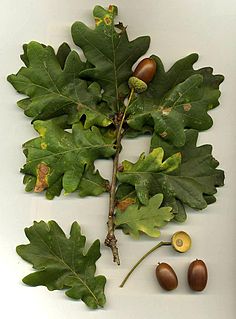
An oak is a tree or shrub in the genus Quercus of the beech family, Fagaceae. There are approximately 500 extant species of oaks. The common name "oak" also appears in the names of species in related genera, notably Lithocarpus, as well as in those of unrelated species such as Grevillea robusta and the Casuarinaceae (she-oaks). The genus Quercus is native to the Northern Hemisphere, and includes deciduous and evergreen species extending from cool temperate to tropical latitudes in the Americas, Asia, Europe, and North Africa. North America has the largest number of oak species, with approximately 160 species in Mexico of which 109 are endemic and about 90 in the United States. The second greatest area of oak diversity is China, with approximately 100 species.

Quercus velutina, the black oak, is a species of oak in the red oak group, native and widespread in eastern and central North America. It is found in all the coastal states from Maine to Texas, inland as far as Michigan, Ontario, Minnesota, Nebraska, Kansas, Oklahoma, and eastern Texas. It is sometimes called the eastern black oak.

Quercus robur, commonly known as common oak, pedunculate oak, European oak or English oak, is a species of flowering plant in the beech and oak family, Fagaceae. It is native to most of Europe west of the Caucasus. The tree is widely cultivated in temperate regions and has escaped into the wild in scattered parts of China and North America.

Quercus garryana is an oak tree species of the Pacific coast of North America, with a range stretching from southern California to southwestern British Columbia. It is commonly known as the Oregon white oak or Oregon oak in the United States and as the Garry oak in Canada. It grows from sea level to 210 meters (690 ft) altitude in the northern part of its range, and at 300 to 1,800 meters in the south of the range in California. The eponymous Nicholas Garry was deputy governor of the Hudson's Bay Company, 1822–35.

Quercus virginiana, also known as the southern live oak, is an evergreen oak tree endemic to the Southeastern United States. Though many other species are loosely called live oak, the southern live oak is particularly iconic of the Old South. Many very large and old specimens of live oak can be found today in the Deep South region of the United States.

Live oak or evergreen oak is any of a number of oaks in several different sections of the genus Quercus that share the characteristic of evergreen foliage. These oaks are not more closely related to each other than they are to other oaks.

Quercus agrifolia, the California live oak, or coast live oak, is a highly variable, often evergreen oak tree, a type of live oak, native to the California Floristic Province. May be shrubby, depending on age and growing location, but is generally a medium sized tree. It grows west of the Sierra Nevada mountain range from Mendocino County, California, south to northern Baja California in Mexico. It is classified in the red oak section of oaks.

Quercus lobata, commonly called the valley oak or roble, grows into the largest of North American oaks. It is endemic to California, growing in interior valleys and foothills from Siskiyou County to San Diego County. Mature specimens may attain an age of up to 600 years. This deciduous oak requires year-round access to groundwater.
Chionodes petalumensis is a species of moth in the family Gelechiidae. It is found in North America from southern British Columbia to California, Arizona and Colorado.
Chionodes chrysopyla is a moth in the family Gelechiidae. It is found in North America, where it has been recorded from California, Arizona, Washington and British Columbia.

Chionodes fuscomaculella is a moth in the family Gelechiidae. It is found in North America, where it has been recorded from Nova Scotia and Quebec to Florida, south-western Wisconsin, eastern Texas and eastern Oklahoma.
Chionodes pereyra is a moth in the family Gelechiidae. It is found in North America, where it has been recorded from Massachusetts and Michigan to Florida and Texas.
Chionodes trichostola is a moth in the family Gelechiidae. It is found in North America, where it has been recorded from south-western British Columbia to California, Utah, Colorado, Arizona and Texas.
Chionodes soter is a moth in the family Gelechiidae. It is found in North America, where it has been recorded from Nova Scotia and south-western Wisconsin to South Carolina and Illinois.
Chionodes sevir is a moth in the family Gelechiidae. It is found in North America, where it has been recorded from Massachusetts to Florida, Kentucky, Texas and North Carolina.
Chionodes restio is a moth in the family Gelechiidae. It is found in North America, where it has been recorded from south-western British Columbia to California.
Chionodes adamas is a moth in the family Gelechiidae. It is found in North America, where it has been recorded from southern Quebec and Manitoba to Mississippi and Texas.
Chionodes messor is a moth in the family Gelechiidae. It is found in North America, where it has been recorded from Nevada and California.








